As rapid erosion threatens beachfront SC homes, residents are left to battle it alone
For more than two decades, Jerry and Vivian Wayne have watched from their waterfront home as the sun rose over the St. Helena Sound and set below a teeming golden marsh.
It’s been their constant since they moved to the last house on Coffin Point’s north end. But today, the Waynes’ home is under assault. Rising seas, natural sediment dynamics and beach erosion have sent waves closer and closer to their stilted house over the past seven years. The threat has prompted 82-year-old Jerry Wayne to wage a one-man war against Mother Nature.
And that’s landed him in hot water with state authorities.
Wayne’s fight isn’t unique. Throughout his community — indeed, all along the South Carolina and the U.S. east coasts — beachfront property owners are fighting severe erosion. The weapons range from massive beach renourishment projects and sea walls to individual property owners moving sand.
“When you’re thinking about the problems we’re trying to fix today, like that particular shoreline at Coffin Point, they aren’t going to stop,” said Rob Young, a coastal erosion expert at Western Carolina University.
When Jerry Wayne armors against rapid erosion, he climbs onto an orange front loader, assesses his boundary line and motors back and forth, collecting and then depositing sand where his property is washing away. It’s a process known as sand scraping. Lately, he’s used the sand to rebuild the disappearing driveway and portions around the stilted house that erode faster than he can renourish.
“It’s a lot of work,” Jerry Wayne said. “And I’m tired of it.”
The state’s Department of Health and Environmental Control has cited Jerry Wayne for scraping sand and placing masonry and stones, without a permit, on the area of the beachfront the agency wants to protect from development. But Wayne says a line marking the protected area is murky, and the sand he excavates is outside the protected area. He explains that his previous violations happened because he was avoiding spots where sea turtles nest, which is near sand dune systems above DHEC’s protected area.
Wayne argues that his sand excavating — essentially a low-scale, one-man beach renourishment project — is more conservation-minded than options other beachfront homeowners have used to safeguard their properties.
Moving sand isn’t the only option the Waynes are seeking. They’re trying to get permits for a wall of stacked boulders that would spare their home.
Some nearby residents have spent tens of thousands of dollars to build private erosion control structures. Others are pushing for natural solutions to stymie erosion.
One resident moved their home landward.
But the Waynes, and others, say they have desperately toed the line of state and local regulations while they await legal approval for other structures that slow erosion, including the Waynes’ wall of stacked boulders.
As parts of Coffin Point’s shoreline rapidly squeeze, protecting residents’ imperiled properties is in their own hands and wallets. Because Coffin Point does not have full and complete public access to its beach, under state statute it’s not eligible for the Beach Renourishment Funding Assistance Grant Program. That means the onus to navigate and pay for home-saving efforts falls to each homeowner. And on some parts of the beach, the destruction is happening more quickly than state lawmakers and agencies move.
When the problems started
Coffin Point residents, with charming houses dotted along the estuarine shoreline, didn’t used to worry about the beach’s crumbling demise.
They knew it as a remote and storied place, marked by a red-roofed, two-story clapboard house in the middle of a once-functioning cotton plantation before the Civil War. In the 1950s, Coffin Point was largely recognized as belonging to the late J.E. McTeer, the hoodoo-practicing longtime Beaufort County sheriff.
Despite Coffin Point’s sandy beachfront, it faces the St. Helena Sound and does not affront the Atlantic Ocean, making it an estuarine shoreline. Because of how it’s situated, the shoreline is not under the state’s beachfront permitting regulations that banned sea walls in 1988. It’s a detail that matters, because it allows state-permitted erosion control structures on Coffin Point.
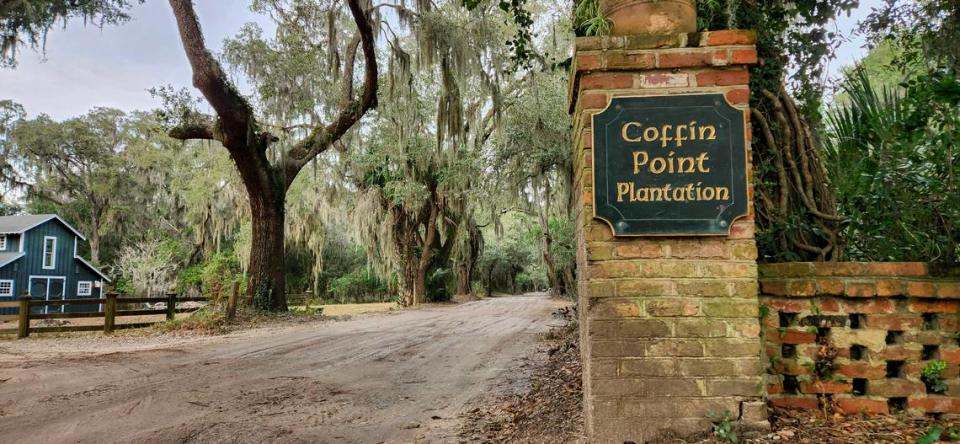
When Jerry and Vivian Wayne left Atlanta for St. Helena Island in the late 1990s, they entered the antithesis of city living and left behind Jerry’s soon-to-end hectic career as a Ford Motor Co. engineer.
Having never seen the property and imagining a more resort-style feel, they took the live oak-lined dirt roads, half a mile past Coffin Point Plantation, and reached the last home on the north end. Then, they looked up.
Sitting on over 120 acres and raised on stilts, their new place was more captivating and unfettered than any resort they could’ve dreamed of.
Beachfront living treated the Waynes well. It was their utopia, and the grandchildren’s summer haven. Vivian tended to the garden. Jerry mowed the grass in front of the house. And the tides’ ebb and flow safely lapped on the wide beach below.
Eighteen years into their bliss, on Oct. 8, 2016, Mother Nature reared her ugly head.
The couple stayed in the home as Hurricane Matthew devastated their utopia and the historic neighborhood. The storm’s pressure imploded their home’s sliding glass doors. Rushing water broke the generator’s gas line. Jerry’s classic cars, stored under the house, clanked back and forth into the home’s pilings. Their boat washed into the sea. Trees twisted, bowed and fell across muddy roads, making it impossible to navigate in and out of Coffin Point. Strong, crashing waves and lashing winds decimated the sandy shoreline.
That’s when all the problems began, the Waynes said.
A fine line
When erosion began to severely affect the Waynes’ property, Jerry first rolled out a wheelbarrow.
He scooped up sand, dropped it into the tray, and trundled it back home to fill in eroded spots. When he swapped it with a smaller wheelbarrow to lighten the load, he couldn’t move sand fast enough to keep up with the incoming high tide. That’s when he switched to the front loader.
Still, one high tide with strong currents can pull away a day’s work of sand excavating, pulling the sand back into the water.
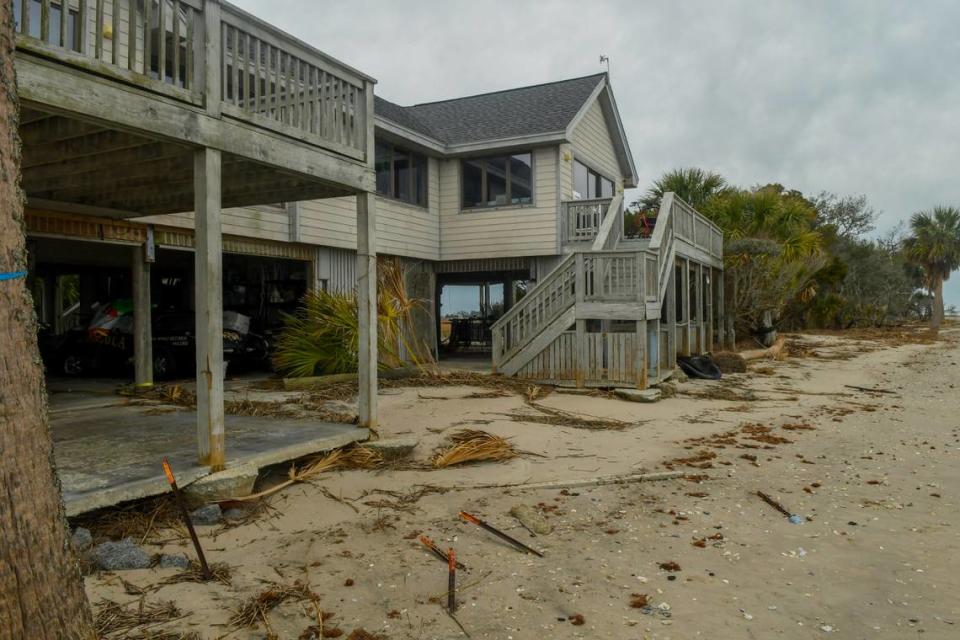
To some, Wayne’s excavation might seem innocuous. But the state doesn’t agree.
Since January 2022, DHEC has twice dinged Jerry Wayne for scraping sand and once for placing rock and masonry stones without the department’s authorization. The agency declined to comment on any fines or pending actions against the Waynes’ sand scraping, as it remains under investigation by the Ocean and Coastal Resource Management compliance and enforcement section.
The agency says Wayne’s efforts would only be allowable as a temporary measure in an emergency situation.
Under state law, DHEC determines the area of each South Carolina beach that must be protected from development or destruction. Most work done in the protected area may require a permit. DHEC’s inspection reports of the Waynes’ property said he scraped sand in the protected area without those permits.
Wayne said he doesn’t need a permit as long as he excavates above the line that demarcates the state’s protected area. He also said the state’s requirements for what and where property can be modified is a moving target.
The line marking the protected area “changes every time they measure it,” he said.
Is putting up walls part of the problem?
Southward of the Waynes, Christina and Travis Washington finally settled into their dream home five years ago.
Leaving Washington, D.C., the couple discovered that St. Helena offered an entire shift of pace and community, one Christina was drawn to for the thriving and rich Gullah Geechee culture. Their Coffin Point beachfront house was tucked away among live oak trees, and the backyard sloped into the beach, where their kids could swim.
“It just felt so idyllic and beautiful,” Christina said.
But since they purchased the home, they’ve lost 20 feet of shoreline and the backyard no longer slopes into the beach. It’s a straight drop off, which requires a ladder to reach the beach. Ten of those feet were whittled away last year from back-to-back days of relentless rain.
While the previous owner installed rip-rap to protect high erosion areas, the Washingtons say they aren’t interested in putting up hard structures to protect their land. They’ve seen how the structures have backfired.
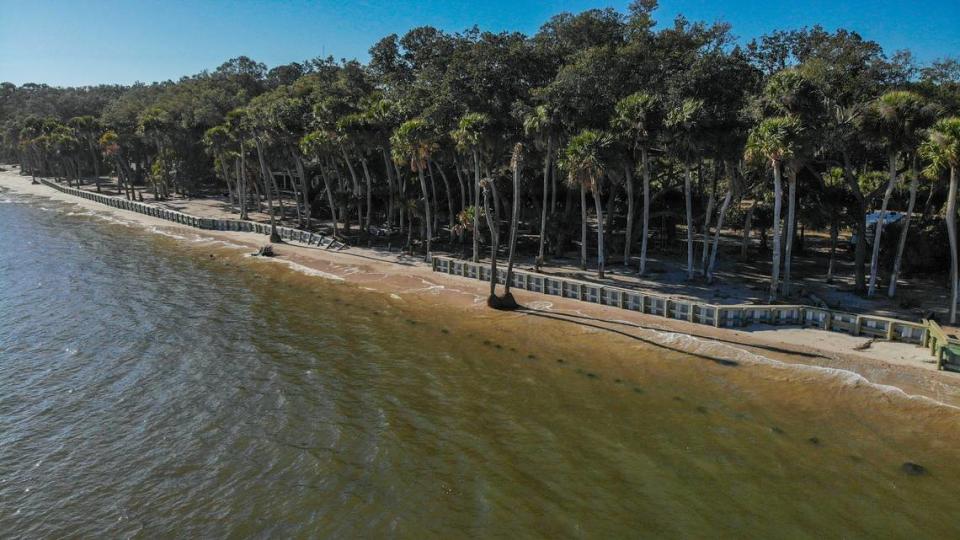
Once the first private timber bulkhead went up issues affecting the beach multiplied, several beachfront residents have said. A timber bulkhead, a vertical wall, works to retain soil but it gives minimal protection from waves. Seawalls also attempt to retain soil but provide more protection from strong surf.
Fronting only the owner’s property, the bulkhead dead-ends into a neighbor’s yard. The bulkheads leave ample space for water to seep behind the bulkhead and more rapidly erode their neighbor’s property. Huge tides and strong storms cause the walls to bend, snap and get washed out.
“I feel like it’s eating away our unprotected area more now that the walls are going up,” Travis Washington said.
Despite the state’s warnings that sea walls and bulkheads aren’t effective, three permits to build timber bulkheads on Coffin Point properties were approved by DHEC within the past three years. Another four permits are under review, according to the agency.
Young, the Western Carolina University coastal erosion expert, said it’s not best practice to have beachfront homeowners choose their own protection methods. Some do more. Some do less. And what one homeowner chooses could impact their neighbors.
“Certainly at the ends of the sea walls where there’s no protection, it will make things worse there,” Young said.
Lagging permitting process
Four years ago, Grant and Lorrie Germann moved into the home next to the Waynes. Within the first two years of beachfront living, their property lost 2 to 3 feet of dunes. The Germanns knew they had to do something and chose to go through the permitting process to build a bulkhead.
But almost immediately after the first king tide came after it was built, the bulkhead was damaged. The Germanns figured it was a one-off, but high tides and east winds that stir up bigger waves kept coming.
While the structure has needed repairs, Grant Germann said the Waynes’ property has eroded faster than his own. But he doesn’t know whether the bulkhead contributed to the Waynes’ severe erosion.
In July, the Germanns applied for a permit to place rip rap in front of the bulkhead to stop the direct force of waves to the structure. Seven months have passed and the state agency has not OK’d the permit.
“We were all on our own and we accept that as part of being able to look out your window and see the open water,” Grant Germann said. “We were willing to do what we need to to protect that.”
But as the permitting process drags along, high tides and strong winds aren’t stopping. And the onus and desperation of protecting Coffin Point beachfront properties falls in the residents’ laps.
It’s a reality that isn’t going to change.
Experts predict sea level rise rates across much of the United States coastline have been accelerating, not moving at a linear rate.
William Sweet, an oceanographer at the National Oceanic and Atmospheric Administration, said in the next 30 years, sea levels are expected to increase by a foot. Groundwater also is expected to rise.
All this water will have nowhere to go, Sweet said.
Shoreline protection’s future
It’s no coincidence that the Waynes, also without a bulkhead, are having the same experience as the Washingtons.
When the water rushes in, Jerry Wayne said, it hits the Germann’s bulkhead and creates a whirling effect that pulls away even more sand. The most recent deluge brought down a tall oak and sent a piling from the wall sailing over to his front yard.
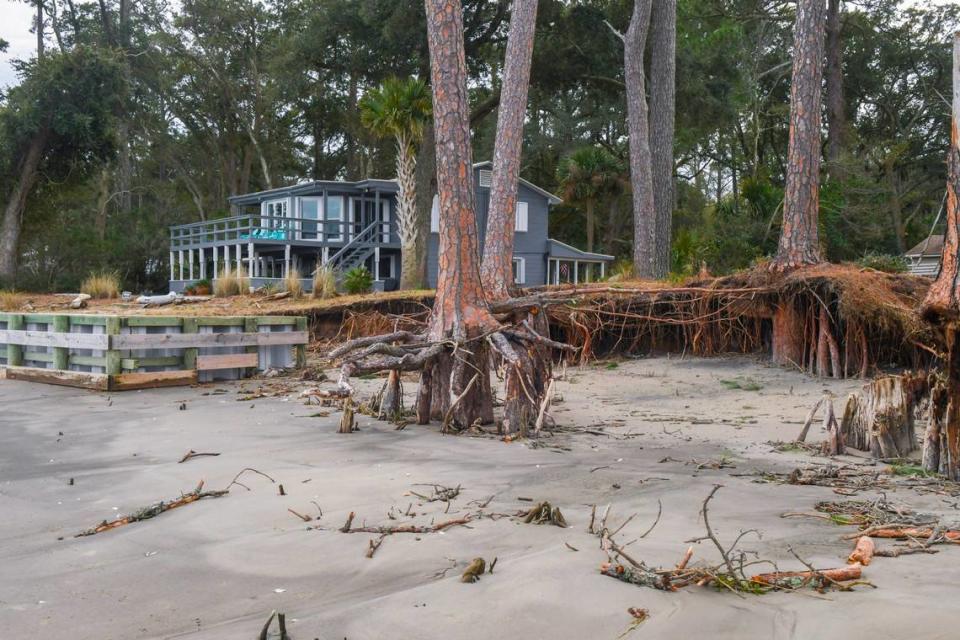
“Once they put that wall in, it just left us wide open,” Jerry Wayne said.
While Coffin Point residents are permitted to install erosion control structures with the state’s approval, Young said he more largely fears for protections the state has had for over three decades.
The protections came from South Carolina’s 1988 Beachfront Management Act that worked to demolish sea walls and promote public access to the beach. But as beachfront homes continue to be built, and sea levels rise and storms lash the coast, Young said he worries the state will backpedal from protections in the act.
“We’re going to see more and more ugly hard structures to protect private property at the expense of what belongs to everybody in South Carolina,” Young said. “We understand that when you build sea walls, it makes the beach disappear. It makes the intertidal zone disappear. And that intertidal zone is public trust land, right? You should be allowed to walk down those shorelines – that’s everybody’s birthright.”
Taking natural measures
At the last house on the south end of Coffin Point, Carolyn Jebaily has watched the land morph in front of her pristine stilted-cottage. But she isn’t interested in rocks and fiberglass or anything that isn’t naturally occurring.
Her beachfront home was once thick with marsh grass and couldn’t be walked on barefoot because of razor-sharp oyster shells. Sea turtle nesting areas were safe and the horseshoe crabs were aplenty. Now, it’s hard to find either creature.
Over time, she watched as erosion ate away at the grasses and left a sandy swath. Once the sand erodes away, there are no buffers against the water.
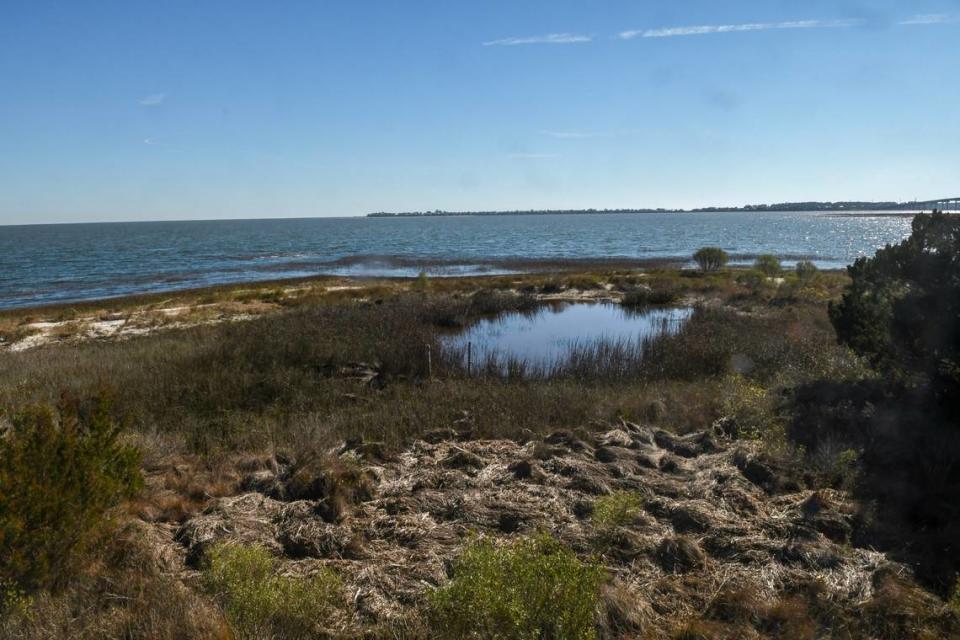
“People think … you should just have an all white sandy beach, but it doesn’t work that way,” Jebaily said. “They come from the North and they don’t understand the natural flora and habitat here.”
Jebaily has heard of Jerry Wayne’s one-man renourishment feat. She’s witnessed others taking sand to widen roads. She’s seen the bulkheads new and damaged.
Having worked in conservation for years, Jebaily knows there’s no controlling storms, King tides or powerful currents and whipping winds, but there is no harm in preserving the natural flora and fauna and protecting existing wetland buffers. She is steadfast about planting in all the right places with native species.
Not giving up the fight
Two miles north of Jebaily, time and the tides are working against the Waynes even faster, it seems.
While Jerry continues to truck sand back and forth when necessary, he and Vivian await a surveyor to start the process of installing boulders in front of their property. Protecting what they once called their utopia, when they had no clue what beachfront living had in store for them, is a waiting game.
Since November, they’ve been trying to have a surveyor come out to kick off the process. DHEC says the average time frame for a critical area permit for an erosion control structure is between four and six months.
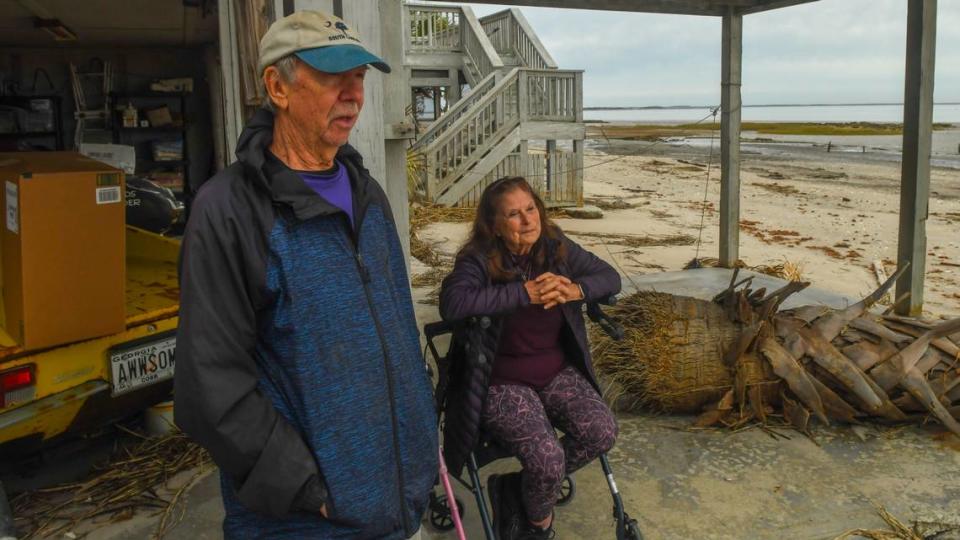
On a January afternoon at low tide, standing on the Waynes’ property, looking toward the water, the couple’s zealous battle to protect their home begins to make sense.
Albeit the once-grassy yard and sandy beach below is now a gushing mudflat with sawed-off piling poking through, the tranquility is undeniable. It’s pin-drop quiet. The water is calm, the breeze is soft. Birds flit in and out of the horizon that’s dotted with a single shrimp boat. It’s the paradise the Waynes loved for decades and won’t let go.
Standing below the stilted-house that afternoon, there was no hesitation in Jerry’s voice when he spoke: “We intend to die here.”

